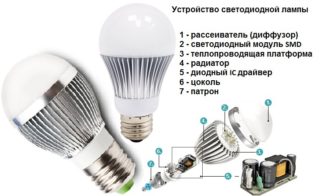LED light sources are characterized by minimal power consumption and brightness. But when the power supply is unstable under the influence of external factors, an unpleasant flickering is observed. If the LED lamp flashes when the switch is off, the problem can be solved by yourself, but only after checking the fact of the ripple.
- Why are cheap bulbs flashing?
- Flashing in the off state of the switch
- The main reasons for working in an abnormal mode
- Flickering due to switch backlight
- Blinking due to mains voltage
- Leakage current
- The problem created by the wiring
- How to correctly detect a malfunction
- Methods to eliminate the blinking of a budget light
- Increasing the capacitance of the capacitor
- Limiting the current flow through the LEDs with a damping resistor
- Using homemade filters
- Completion of the wiring
- Switch replacement
- Removing a diode
- Switch replacement
- Organization of a separate neutral
- Reasons for flashing lights when on
- Features of testing the flicker of a lamp on
Why are cheap bulbs flashing?
More expensive devices are equipped with pulse step-down drivers. Due to the feedback chain, the elements are able to stabilize the voltage, so the lamps practically do not blink.
Flashing in the off state of the switch

The LED luminaire is equipped with electronic converters and diodes connected to its outputs. When voltage is applied to the circuit, it is converted to the desired value with further supply to the LEDs.
If the electrical circuit does not provide a transformerless power supply, impulse noise is not eliminated, and there is no galvanic connection from the lines. It is also impossible to smooth out ripple without an electrolytic capacitor.
Additional circuits are connected to the sensor contacts - illumination, current limitation. When the position of the contact group of the switch or relay is changed, the lamp is constantly energized. The normally closed state of the contacts contributes to the supply of a voltage of 220 V to the light source. In the normally open position, the backlight or spark-suppressing circuit current is supplied to it. They cause the blinking effect.
The main reasons for working in an abnormal mode
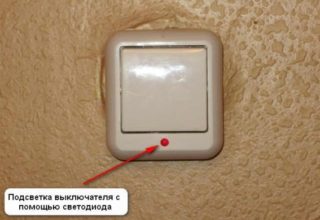
An alternating current is used to power the household network. In this case, the LED equipped with a rectifier with a filter will remain intact. When voltage builds up, blinking is observed.
The phenomenon may have another reason:
- Wrong wiring diagram. Zero goes to the switch, the phase goes to the lamp, zero is grounded.
- The presence of a backlight mode at the switch.
- The close location of equipment with a strong magnetic field - a radio station, a large TV, a cell tower.
- Laying wiring inside a damp wall.
- The presence of several cables in the strobe.
These factors create parasitic currents that disrupt the operation of LED lamps.
Flickering due to switch backlight
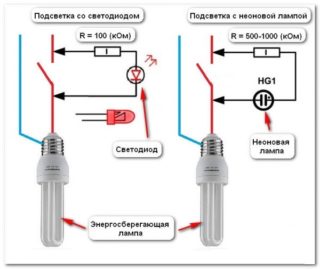
The illumination of the ceiling lamp, combined with the brightness indicator, provokes flashes of the power of the diode.To understand the reason, you need to understand the design of the device.
The backlight has resistors and diodes, so there is no break in contacts when turned off. The resistor passes a small current, accumulates it in a capacitor. After an overflow, the residual currents flow into the lighting fixture. The amount of current is not enough to turn on, so the lamp blinks periodically.
Blinking due to mains voltage
A common cause of a malfunction is low voltage parameters. The voltage of 220 V is not enough for a high-quality glow of a source with a built-in driver. The phenomenon is typical for lamps connected by means of a dimmer. Without the support of this parameter, the dimmer will not work at full power, flickering will appear. The problem can be solved by adjusting the rating or mounting the stabilizer.
Only lamps rated for 180-250 V will work without blinking.
Leakage current
The rectifier at the driver input is designed as a diode bridge with a filtering capacitor. During operation, the current remains on it for charging. Once a sufficient amount has accumulated, the surplus begins to spread out, causing outbreaks. Leakage also occurs through poor-quality insulation of the conductors directed to the switch. A low current flow leads to flickering, melting of the wiring, and emergency situations.
Lamps with high input capacitor capacitance practically do not blink.
The problem created by the wiring
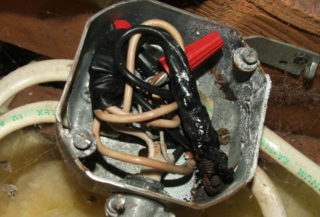
When the LED light is flashing off, the problem may be the wiring diagram. When arranging the lighting line, the phase from the box is fed to the switch, zero to the luminaire. In the confused position, the capacitor is continuously charged and the switched off LED blinks.
If the diagram is observed, the blinking lamp signals the induced voltage. There may be other cables with the lighting fixture wires. To get rid of the phenomenon, you need to completely change the wiring.
If the house is located in a damp area, an RCD is installed to protect against flicker.
How to correctly detect a malfunction

To find a problem, you need to look at the frequency of flashes and search for the phase and neutral conductors using an indicator screwdriver. The phase thrown on the contact of the switch indicates the serviceability of the network. The supply of current to the lamp provokes flashing.
If the breakdown remains, you will need:
- change the switch;
- inspect the wiring for breakage of insulation or oxidation of contacts;
- check the voltage stability by turning on the breaker.
With normal inspection parameters and re-detection of the problem, it is worth installing a new light bulb.
Methods to eliminate the blinking of a budget light
The easiest way to solve the flashing lamp problem is to remove the backlight. This option is not suitable for modern switches. If the light source is inexpensive, you can use one of the technologies described below.
Increasing the capacitance of the capacitor
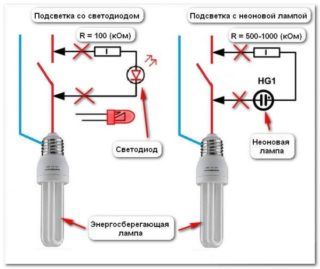
As a resistor, it is allowed to use a paper or ceramic capacitor with a capacity of 0.01-1 μF with a voltage of 630 V. The element has a minimum power consumption and heating.
You will need to solder two resistors to one switch.
Limiting the current flow through the LEDs with a damping resistor
A low-power 1-2 W resistor can be included in the LED light source circuit. The product will accept leakage currents that charge the capacitor.
The resistor is installed in the junction box, since it will heat up when turned on. For additional protection, it is allowed to use a heat-shrinkable tube. With proper installation, the diodes will stop flickering.
Using homemade filters
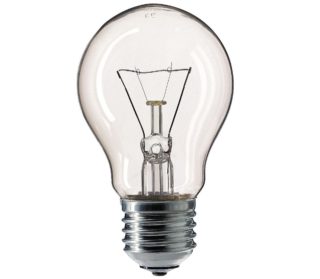
When the LED lamp blinks when the light is off, it is worth making a homemade filter. You will need an incandescent light bulb screwed into the second socket as close to the input voltage point as possible. The product will be a kind of pulse receiver.
The lack of technology is the presence of one socket in the chandelier. If you install an incandescent lamp with a high power, electricity will not be saved. The situation can be easily corrected by installing an LED source in one horn, and a low-power 25-40W source in the second.
Completion of the wiring
Changing the places of the phase and zero leads to the breakage of the latter on the switch with the further supply of the phase to the light source. Even a capacitor with an increased capacity will flash. The solution to the problem is to replace the phase:
- changing the location of the neutral and phase in the distribution box for the entire house or apartment;
- similar work in the distribution box of the premises.
Use a multimeter or indicator screwdriver to locate the phase cable.
Switch replacement
After installing a new switch, the visible flicker will disappear. The light bulb will pulsate, but without the perception of the glow by the organs of vision. The disadvantage of technology is increased eye fatigue, the negative impact of blinking on the nervous system.
The normal ripple factor is no more than 5%.
Removing a diode
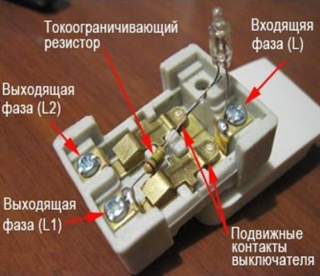
The technology is suitable for models without blink protection in shutdown mode. For work, you will need a slotted or Phillips screwdriver, nippers, pliers, and a voltage indicator.
If the light source has a diode resistor on the board, it can be turned off. You will need to do the following:
- De-energize the line through the circuit breaker.
- Check the presence of voltage on the contacts.
- Remove the switch from the box in the wall. The movable pads are removed with a screwdriver, and then they are pulled with force towards the floor.
- Remove the retaining screws from the switch antenna.
- Disconnect the diode by breaking the wire with pliers.
In order not to cut the electrical circuit, you need to check the lamp power with a tester.
Switch replacement
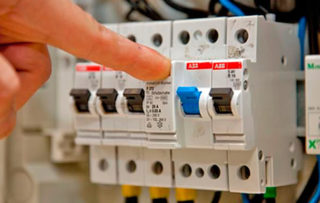
It is worth making a replacement when there is no way to turn off the diode on the switch. For work, you need a large and small screwdrivers, wire cutters and pliers. The replacement process is implemented as follows:
- Ensuring the safety of events. The power is turned off in the shield and the network is checked for voltage.
- Removing the decorative strip, removing the switches from the niche in the wall.
- Remove switch wires, install a new switch, and connect cables to it.
- Laying the veins.
- Installing the fittings so that the power cable does not get caught under the clamps.
- Reassemble the new switch in reverse order.
To avoid confusion, label the conductors and sockets.
Organization of a separate neutral
The method is acceptable at the stage of repair work or with an external type of wiring. You will need to connect individual phase and neutral wires to the backlight. The switch can be easily found in the dark, the flashing light will disappear.
Reasons for flashing lights when on
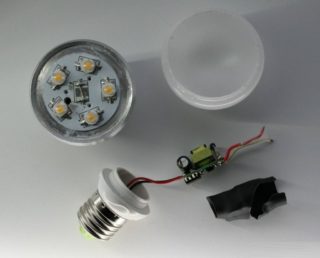
If the light blinks when the light is off and off in the house or apartment, you will need to replace the starting device. When the problem persists, you will need:
- Check voltage parameters. If there is a fault, the light source will pulsate. The indicator below 5% will be the reason for contacting the energy sales company.
- Inspect the trigger. The LEDs in this case will pulsate when turned on, which will affect the duration of the lamp.
- Disassemble the device and check the quality of the diode matrix. With a classic connection, there is a ripple in the output voltage.The brightness of the stream decreases, but it can be increased by a capacitor. This method is not suitable for residential premises.
Under low voltage conditions, the life of the LED lamp is reduced by 20%.
Features of testing the flicker of a lamp on
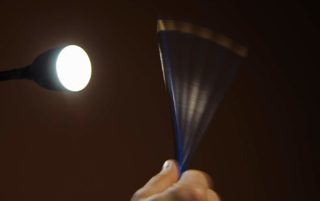
It is difficult to establish the presence of blinking, since the eye does not perceive such pulsations. To prevent fatigue, insomnia and harmful effects on the psyche, you need to check the lamp.
- With a pencil. In a dark room, turn on only the lamp. A simple pencil is drawn over the device. An intermittent trace indicates pulsation, a solid trace indicates that there is no blinking.
- Using a smartphone camera. At a distance of 1 m, the camera is aimed at the turned on lamp in the video recording mode. Dark bars on the display will confirm that there is a ripple.
Breakage is most often observed in budget models. But the main reasons for blinking in turn-on mode are insufficient capacitor capacity or incompatibility with the dimmer (the load of the regulator exceeds the load of the LED).
Blinking of LED light sources is observed due to poor connection, overvoltage and leakage current. You can fix these problems yourself. If, after repair, the pulsations have not stopped, there is a possibility of a malfunction of the switch, incompatibility of the cartridge with the lamp, breakdown of the driver, end of the period of operation, or damage to the lamp under the influence of high temperatures and vibrations.

